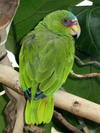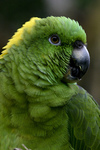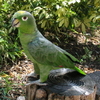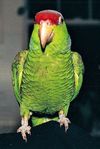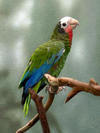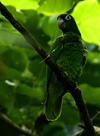Genus Amazona

Blue-fronted Amazon - The Blue-fronted Amazon is a mainly green parrot about 38 cm long. They have blue feathers on the forehead above the beak and yellow on the face and crown. Distribution of blue and yellow varies greatly among individuals. Unlike most other Amazona parrots, its beak is mostly black. There is no overt sexual dimorphism. Juveniles of all parrots are duller and have dark irises.
Black-billed Amazon - The Black-billed Amazon lives in mountainous rainforest, usually limestone rainforest, feeding on fruit, seeds, and nuts, and will take cultivated fruit like mangos, papayas and cucumbers as well as wild fruits.
White-fronted Amazon - The White-fronted Amazon, Amazona albifrons, also known as the White-fronted Parrot, or adopted slang term Spectacled Amazon Parrot is a Central American species of parrot. Not to be confused with the Red-spectacled Amazon. They also can imitate a range from 30 to 40 different sounds. Like other large parrots, the White-fronted Parrot has a long potential life span, usually around 40 years.
Orange-winged Amazon - There are two subspecies:
Red-necked Amazon - It is green, with bright splashes of various colours. Its name is due to the area of red plumage commonly found at its throat.
Yellow-naped Amazon - It is found along the Pacific coast from southern Mexico south to northern Costa Rica. It is distinguished by its green forehead and crown and a yellow band across the lower nape and hindneck. The beak is dark grey and is paler towards the base of the upper mandible. The feet are also dark grey.
Red-lored Amazon - It is 32–35 cm long, with a weight of 310–480 g. The plumage is primarily green, with red forehead and in some subspecies yellow cheeks . The crown is blue. Adult males and females do not differ in plumage. Juveniles have less yellow on cheeks, less red on forehead, and dark irises.
Yellow-shouldered Amazon - The Yellow-shouldered Amazon is mainly green and about 33 cm long. It has a whitish forehead and lores, and a yellow crown, ocular region and - often - ear coverts and chin. The bare eye-ring is white. The thighs and the bend of the wing are yellow, but both can be difficult to see. The throat, cheeks and belly often have a bluish tinge. As most members of the genus Amazona, it has broad dark blue tips to the remiges and a red wing-speculum. Its beak is horn coloured.
Red-tailed Amazon - Red-tailed Amazons weigh around 425 g and are approximately 35 cm long. As expected from its common name, it has a broad red band on its tail, but as it largely is limited to the inner webs of the feathers, it is mainly visible from below or when the tail is spread open. Additionally, the tail has a broad yellow tip, and the outer rectrices are dark purplish-blue at the base. The remaining plumage is green, while the throat, cheeks and auriculars are purple-blue, the forecrown is red, and the retrices are broadly tipped dark blue. It has a yellowish bill with a blackish tip to the upper mandible, a pale grey eye ring, and orange irises. Juveniles have a duller plumage and a brown irises.
Yellow-billed Amazon - The Yellow-billed Amazon was one of the many species originally described by Linnaeus in his 18th century work, Systema Naturae.
Blue-cheeked Amazon - It is about 34 cm. Its coloring is mostly green, with blue cheeks from around the eye to the neck , a yellow-orange wing speculum, a yellowish crown, and orange lores .
Mealy Amazon - The Mealy Amazon occurs in tropical Central America and South America. It frequents humid to semi-humid forest and plantations. In regions dominated by open/dry habitats it is restricted to gallery forest or completely absent.
Festive Amazon - The subspecies bodini has more red to the forecrown and more blue to the face than the nominate. In flight, both subspecies show deep blue outer wings and a red rump, but the latter is reduced in juveniles.
Lilac-crowned Amazon - In 2006 BirdLife International classified this species as Vulnerable.
St. Vincent Amazon - 40 cm long, mostly green, multi-colored amazon parrot with a yellowish white, blue and green head, greenish-bronze upperparts, grey feet, reddish eye, and violet blue-green wings. Its tail feathers are blue with broad yellow tips. There is a less yellow-brown morph and a less common green morph. It has grey feet and reddish eyes. Both sexes are similar. The young has lighter plumage and brown iris.
Imperial Amazon - The Imperial Amazon is endemic to mountain forests of the Caribbean island nation of Dominica in the Lesser Antilles, Its diet consists mainly of fruits and seeds. It nests in hollow trees.
Kawall - Considerable taxonomic confusion has surrounded this species. "Aberrant Mealy Amazons", which actually were the Kawall's Amazon, were first noted in more than 100 years ago, but it was only in 1989 the Kawall's Amazon was recognised as a species after Brazilian bird keeper Nelson Kawall received a few unusual amazons. Although it resembles the Mealy Amazon, the Kawall's Amazon can easily be recognised by its white patch of skin at the base of the bill, relatively small grey ocular ring , red near the base of the tail, overall brighter green hue and voice.
Bahaman parrot - The Cuban Amazon is a medium-sized parrot 28–33 centimetres long.
Yellow-crowned Amazon - Subspecies in the nominate group have a total length of 33–38 cm . As most other Amazon parrots, it has a short squarish tail and a primarily green plumage. It has dark blue tips to the secondaries and primaries, and a red wing speculum, carpal edge and base of the outer tail-feathers.
Yellow-headed Amazon - This species is part of the Amazona ochrocephala complex, which also includes the Yellow-naped Amazon . This complex, "a taxonomic headache",
Red-spectacled Amazon - Its natural habitats are subtropical or tropical dry forests, subtropical or tropical moist lowland forests, subtropical or tropical moist montane forests, dry savanna, and plantations . It is threatened by habitat loss.
Red-browed parrot - It is threatened by habitat loss and capture for the wild parrot trade.
Tucuman Amazon - The Tucumán Amazon is a mostly green short tailed parrot 31 cm long. The green feathers of the upper-body have black margins. There is red plumage on the forehead and fore-crown, and the red does not extend around the white eye-rings. It has red primary wing feathers and no red at the bend of the wing. It has orange thighs and red at base of the green tail. They have a horn coloured beak, orange-yellow irises, and pinkish-grey legs. The male and female are identical in external appearance. Juveniles have less red on the head, green primary wing feathers, green thighs, and grey irises.
Hispaniolan Amazon - The main features that differentiate the Hispaniolan parrot from other amazons are the white forehead, pale beak, white eye-ring, blue ear patch, and red belly.
St. Lucia Amazon - Its natural habitat is subtropical or tropical moist montane forest. It is threatened by habitat loss. The species had declined from around 1000 birds in the 1950s to 150 birds in the late 1970s. At that point a conservation program began to save the species, which galvanised popular support to save the species, and by 1990 the species had increased to 350 birds.
Vinaceous-breasted parrot - Its natural habitats are subtropical or tropical moist lowland forests, subtropical or tropical moist montane forests, and plantations. It is threatened by habitat loss.
Green-cheeked Amazon - Their appearance is generally green with the most notable features being a bright red forehead and crown, dark blue streaks behind the eyes, and light green cheeks.
Puerto rican parrot - The Puerto Rican Amazon reaches sexual maturity between three and four years of age. It reproduces once a year and is a cavity nester. Once the female lays eggs she will remain in the nest and continuously incubate them until hatching. The chicks are fed by both parents and will fledge 60 to 65 days after hatching. This parrot's diet is varied and consists of flowers, fruits, leaves, bark and nectar obtained from the forest canopy.


